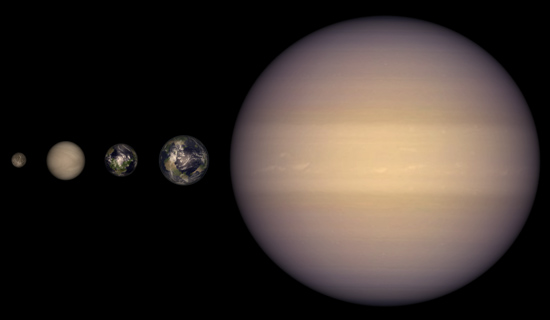
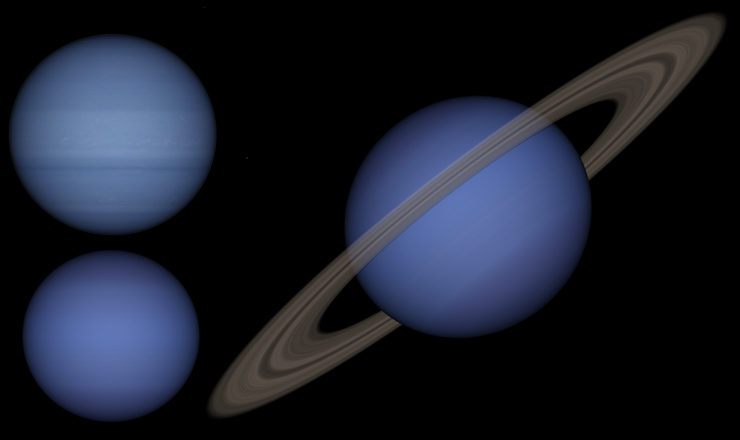
 |
 |
| Right Ascension | 19h 32m |
|---|---|
| Declination | +69° 40' |
| Distance | 18.79 ± 0.04 ly |
| Spectral Class | K0V |
| Estimated Mass | 0.89 × Sol |
| Luminosity | 0.39 × Sol |
| Sigma Draconis as seen from Sol. |
Sol as seen from Sigma Draconis. |
|---|---|
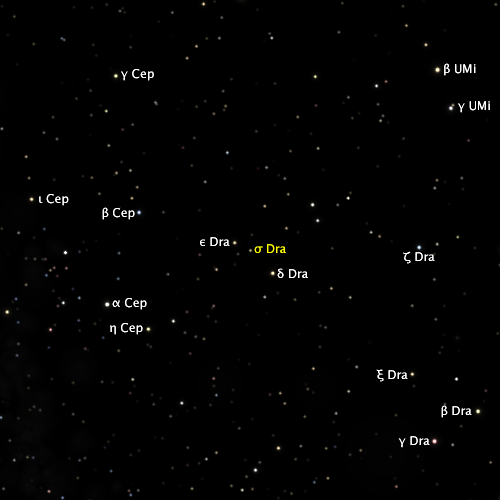 |
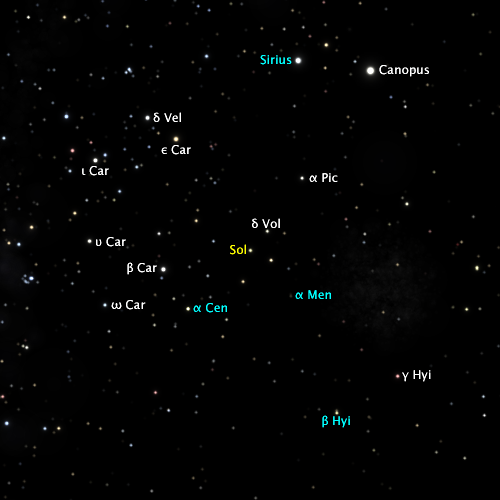 |
| Star | Magnitude | Distance |
|---|---|---|
| Vega | −1.33 | 13.4 |
| Canopus | −0.49 | 327.0 |
| Alpha Aurigae (Capella) | −0.19 | 37.7 |
| Arcturus | −0.18 | 34.5 |
| Rigel | 0.20 | 870.9 |
| Betelgeuse | 0.47 | 501.9 |
| Achernar | 0.68 | 154.8 |
| Beta Centauri (Hadar) | 0.69 | 407.1 |
| Sirius | 0.88 | 24.9 |
| Alpha Crucis (Acrux) | 0.88 | 338.6 |
| Altair | 0.94 | 18.1 |
| Aldebaran | 0.94 | 68.8 |
Sigma Draconis is a K0-class dwarf star located about 18.8 light years from Sol.
Vega is the brightest star in the sky as seen from this stellar system, due to its being much closer to Sigma Draconis than it is to Sol. Canopus is also a prominent star in the skies here, like all other systems in Local Space. Canopus is the second brightest star as seen from the Sigma Draconis system.
| Destination | Distance |
|---|---|
| 61 Cygni A | 11.2 |
| Chara | 23.2 |
| Eta Cassiopeiae A | 11.2 |
| Gliese 226 | 16.5 |
| Vega | 13.4 |
In Local Space, the system is notable for being the only star system in Local Space with more than one habitable world. The two habitable worlds make the Sigma Draconis system an important system in Local Space.
Probes from the Dandelion Project reached the system in 2734.
| Planet | SMA (AU) |
Orbital Period |
e | Equatorial Diameter (km) |
Mass (Earths) |
Density (g/cm3) |
Gravity (Earth g) |
Atmospheric Pressure (Earth=1) |
Sidereal Day |
Mean Solar Day |
Axial Tilt |
Known Moons |
|---|---|---|---|---|---|---|---|---|---|---|---|---|
| Marth | 0.2225 | 40.655 d | 0.0029 | 4586 | 0.03435 | 4.06 | 0.2656 | 0.00000300 | 40d 15h 43.3m | Synchronous | 00° 08.4' | 0 |
| Rozansha | 0.3640 | 85.088 d | 0.0168 | 11830 | 0.7459 | 5.14 | 0.8672 | 13.4 | 85d 02h 06.3m | Synchronous | 00° 41.0' | 0 |
| Shandiana | 0.6284 | 192.97 d | 0.0265 | 9946 | 0.4289 | 4.99 | 0.7051 | 0.707 | 1d 00h 57.4m | 1d 01h 05.5m | 13° 17.8' | 1 |
| Mareenia | 0.8948 | 327.90 d | 0.0600 | 14930 | 1.618 | 5.58 | 1.181 | 1.89 | 22h 57.9m | 23h 01.9m | 14° 39.5' | 2 |
| Khant | 3.469 | 6.8535 y | 0.0587 | 92690 | 76.13 | 1.16 | 1.441 | &mdash | 11h 08.6m | 11h 08.7m | 37° 28.9' | 14 |
| Noron | 6.600 | 17.983 y | 0.0643 | 62050 | 31.37 | 1.55 | 1.325 | — | 1d 17h 26.6m | 1d 17h 27.2m | 16° 39.5' | 5 |
| Callia | 52890 | 18.59 | 1.48 | 1.081 | — | 1d 17h 26.6m | 1d 17h 27.2m | 16° 37.8' | ||||
| Vennover | 12.03 | 44.278 y | 0.0842 | 76570 | 49.41 | 1.37 | 1.370 | &mdash | 08h 59.8m | 08h 59.8m | 38° 43.9' | 11 |
| Name | Diameter (km) |
Period (days) |
Semimajor Axis (km) |
Ecc | Inc |
|---|---|---|---|---|---|
| Natural Satellites of Shandiana | |||||
| Hurmia | 489 | 3.756 | 76990 | 0.0179 | 0.17 |
| Natural Satellites of Mareenia | |||||
| Nelanth | 944 | 3.299 | 109900 | 0.0013 | 0.94 |
| Tarna | 1885 | 13.54 | 281700 | 0.0234 | 1.06 |
| Natural Satellites of Khant | |||||
| Khant VI | 76 | 0.6154 | 129500 | 0.0001 | 0.03 |
| Khant IV | 815 | 1.481 | 232600 | 0.0012 | 0.06 |
| Khant I | 2799 | 2.463 | 326500 | 0.0084 | 0.98 |
| Khant II | 3566 | 4.918 | 517700 | 0.0081 | 0.07 |
| Khant VII | 113 | 4.918 | 517700 | 0.0165 | 0.76 |
| Khant III | 2557 | 9.052 | 777600 | 0.0063 | 1.78 |
| Khant VIII | 200 | 12.04 | 940600 | 0.0288 | 1.48 |
| Khant IX | 127 | 19.65 | 1304000 | 0.0045 | 1.39 |
| Khant XI | 92 | 24.15 | 1496000 | 0.0063 | 1.47 |
| Khant XII | 64 | 42.29 | 2173000 | 0.0086 | 5.11 |
| Khant V | 1641 | 93.32 | 3684000 | 0.2045 | 22.78 |
| Khant X | 156 | 173.4 | 5567000 | 0.0696 | 4.50 |
| Khant XIII | 86 | 238.1 | 6877000 | 0.0378 | 21.54 |
| Khant XIV | 67 | 257.6 | 7249000 | 0.0322 | 13.89 |
| Natural Satellites of Noron-Callia | |||||
| Noron-Callia I | 2139 | 12.23 | 826000 | 0.0030 | 0.58 |
| Noron-Callia II | 1763 | 24.47 | 1311000 | 0.0011 | 1.37 |
| Noron-Callia III | 1399 | 40.78 | 1843000 | 0.0133 | 1.51 |
| Noron-Callia IV | 438 | 107.0 | 3507000 | 0.0773 | 1.46 |
| Noron-Callia V | 208 | 233.0 | 5891000 | 0.1071 | 5.16 |
| Natural Satellites of Vennover | |||||
| Vennover VII | 34 | 0.5056 | 98380 | 0.0006 | 0.71 |
| Vennover III | 228 | 0.6140 | 112000 | 0.0004 | 1.18 |
| Vennover VIII | 33 | 0.7188 | 124400 | 0.0012 | 0.24 |
| Vennover IX | 38 | 0.8905 | 143500 | 0.0009 | 1.70 |
| Vennover X | 32 | 0.9466 | 149400 | 0.0053 | 0.37 |
| Vennover I | 1769 | 2.265 | 267400 | 0.0033 | 0.96 |
| Vennover IV | 139 | 2.265 | 267400 | 0.0055 | 1.80 |
| Vennover V | 169 | 12.89 | 852100 | 0.2580 | 154.96 |
| Vennover II | 2072 | 17.39 | 1041000 | 0.0934 | 163.01 |
| Vennover XI | 67 | 122.9 | 3831000 | 0.1020 | 12.20 |
| Vennover VI | 250 | 345.2 | 7629000 | 0.6579 | 21.26 |
Marth is a small world about the size of Mercury but less dense. It is heavily cratered and possesses only a trace of atmosphere.
The planet has reserves of several important minerals that are mined by crawler. The mining of these minerals is difficult on the sunside due to the oppressive heat. The crawlers used on the Marth mining runs have thick insulation, efficient cooling units and are able to deploy a parasol for shade. These modifications bring the heat down to bearable levels.
Mining on the darkside has its own difficulties. The lack of light makes it more difficult for prospectors to locate the minerals and ores, and all mining takes place under artificial light. The cold is also problematic but it is less of a hindrance to mining than the oppressive heat of the sunside.
Rozansha is a Venuslike world with a runaway greenhouse effect and a thick atmosphere composed mostly of carbon dioxide. The world is almost identical in size to Venus. The atmospheric density of Rozansha is about 13 times that of the Earth, or about one-seventh as dense as that of Venus.
The atmosphere of Rozansha was mined for carbon dioxide and other gases when Mareenia was terraformed.
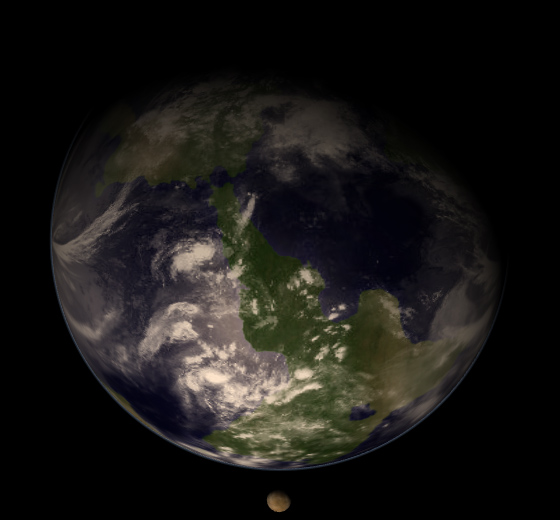 |
Shandiana is one of two habitable worlds in this system. Shandiana is a low-gravity world with a mass only about half that of the Earth.
The world was originally a barren lifeless wasteland. Shandiana was terraformed over a period of two centuries. The terraforming was halted before the oceans were raised to a more Earthlike level to avoid submerging a number of valuable ore deposits.
Shandiana is a warm world with small oceans that cover about 62% of the surface. The large land area causes the climate to be relatively dry, causing Shandiana to have large areas of desert. The main continent of Zarjisar is mostly inhospitable with large ares of desert, badlands and other unfriendly terrain. The world also has smaller landmasses with more pleasant climates and adequate rainfall.
The short solar year — roughly equivalent to half a standard year — and consequent short growing season makes it difficult to grow some unmodified Earth crops in temperate-zone districts that experience the short Shandiani winter. Such districts instead grow hardy crops that are able to withstand the winter, or that have a short growing season.
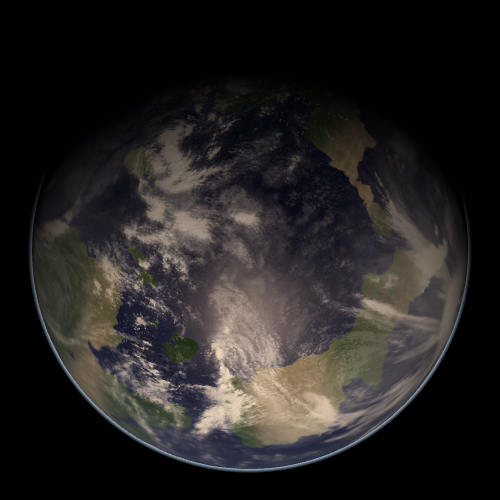 |
Mareenia is the other habitable world in this system. It is substantially larger than Shandiana, with a mass of about 1.6 Earth masses. The extra mass makes the world a high-gravity world. The world has substantial oceans that cover about 82% of the planet's surface. The greater area of the oceans causes Mareenia to have little more land than the smaller sister world, despite the larger size.
The world was originally a glacier-covered world that was devoid of life. The terraforming of Mareenia began with the introduction of greenhouse gases into the atmosphere. The sibling world of Rozansha provided a convenient and plentiful source of carbon dioxide. Fluorocarbons were also employed for their greenhouse effect, particularly CF4 (tetrafluoromethane). Soot was also spread on the ice to increase its thermal absorption. Once the greenhouse gases raised the temperature enough to melt the glaciers, the terraformers introduced a basic biosphere to oxygenate the atmosphere. The terraforming process took about 180 years. Mareenia served as a test ground for advanced terraforming techniques that were intended to be employed on other cold worlds such as Mars and Binaria Major. The techniques used proved too expensive due to the great amount of fluorine required, and the availability of other more clement worlds for terraforming made the terraforming of cold worlds unnecessary in the short term.
The climate of Mareenia is generally cold and wet. The plentiful rainfall allows a variety of crops to grow without needing irrigation. However, the large ocean area often causes strong storms because there is less land to dissipate the force of the storms. The seas of Mareenia must be travelled with care lest a storm sinks the ship. Oceanships on Mareenia are very sturdy to guard against the fierce storms. Despite the generally moist climate, Mareenia has bands of desert on either side of the equator as a consequence of Hadley cell circulation in its atmosphere.
Mareenia possesses two moons that are large enough to show large disks in the sky, which is unusual for terrestrial planets. Usually a terrestrial planet with multiple moons only has small moons, or one large moon at most. The larger moon of Mareenia orbits farther from the planet, and this configuration is stable. The smaller, closer moon is called Nelanth, and the larger, more distant moon is Tarna.
The residents of Mareenia tend to be shorter and stockier than their Earthborn ancestors due to the heavier gravity of the world. These characteristics are also shared by the animals and plants of Mareenia. The difference in gravity between the light gravity of Shandiana and the heavy gravity of Mareenia makes it difficult for residents of Shandiana to migrate to Mareenia. The Mareenian immigration authority only admits immigrants from Shandiana who receive medical clearance. Few Shandiani over the age of 90 Shandiani years (about 471/2 Standard years) receive the necessary clearance. There are fewer restrictions for migration from Mareenia to Shandiana. A steady trickle of wealthy Mareenians migrate to Shandiana in later life to seek the warmer climate and lighter gravity of the smaller world. Migrants from Mareenia to Shandiana generally do so after acclimatizing to a low-pressure atmosphere for a few months in a mountain range on Mareenia so they can cope better with the lower atmospheric pressure of Shandiana.
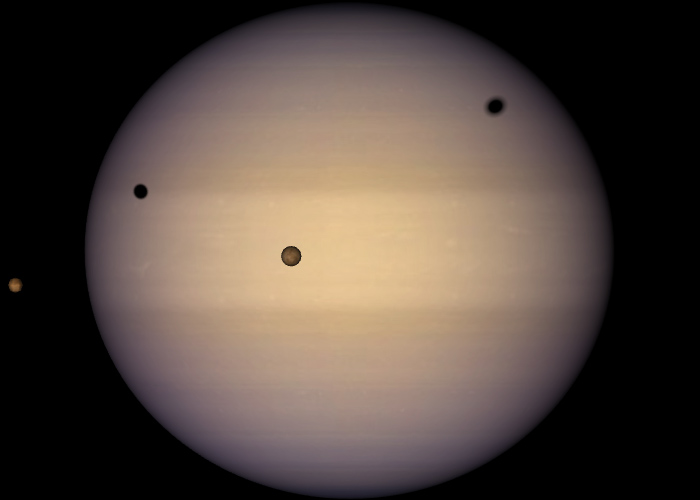 |
Khant is pronounced /xænt/ (chant), with /x/ (ch) being the same sound as ch in Scottish loch or German Bach. Alternatively it may be pronounced as /kænt/ (kant) or /hænt/ (hant).
Khant is the most massive planet in the Sigma Draconis system, with a mass about 80% of Saturn and 24% of Jupiter. The planet resembles Saturn closely, but without Saturn’s rings.
The planet possesses four large moons and an assortment of smaller satellites. Three of the large moons — Khant I, II and III — orbit the planet closely, and are locked in a 1:2:4 resonance similar to the moons of Jupiter. The other large satellite, Khant V, is an oddball world that appears to be a captured world. For a large moon, its orbit is unusually wide, is inclined at about 20 degrees and eccentric. Khant V is captured into a 3:2 rotational resonance like Mercury in the Solar system rather than being tidelocked like most satellites.
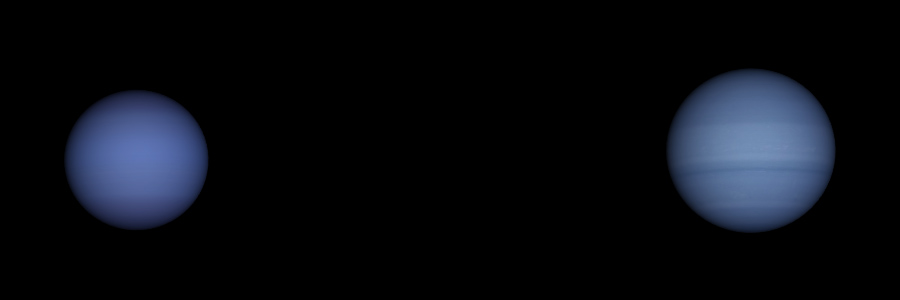 |
Noron and Callia are a binary gas giant. Considered separately, the worlds are unremarkable blue gas giants of a kind that are common in the galaxy. Together they make a striking pair of worlds. The worlds are smaller than the binary planets Cyania and Azuria in the Epsilon Indi system, and have a similar separation. Like Cyania and Azuria, Noron and Callia are locked together in synchronous rotation.
The larger world of Noron has prominent shaded bands on either side of its equator. Callia has much more subdued cloud features, with its faint bands barely visible. At infrared wavelengths, Callia’s cloud bands are more prominent.
The twin worlds have a small system of moons, none of which orbit closer than 800,000 kilometres.
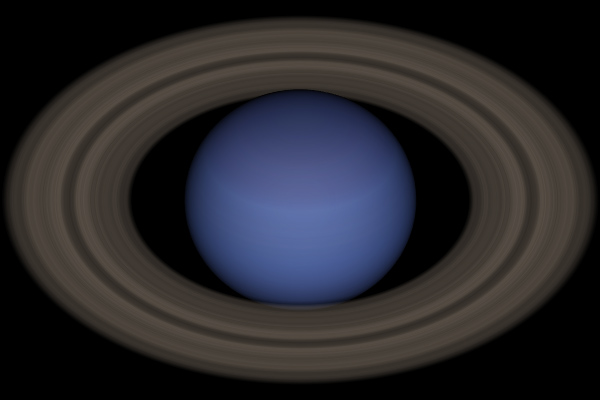 |
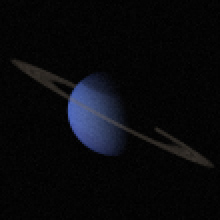 |
The blue methane world of Vennover is the most distant planet in the Sigma Draconis system. Its most striking feature is its large and bright ring system, which are nearly as prominent as the famous rings of Saturn. The beige-hued rings form a striking contrast with the blue colour of the planet.
The planet has a normal system of moons in close. Farther out from the planet is a pair of moons in retrograde orbits that exert their dominance over the outer reaches of the moon system.